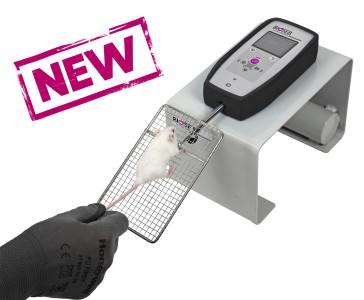Authors
J. J. Luszczki, S. L. Kocharov, S. J. Czuczwar.
Lab
Medical University, Department of Pathophysiology, and Institute of Agricultural Medicine, Department of Physiopathology, Lublin, Poland.
Journal
Neuroscience Research
Abstract
The aim of this study was to determine the influence of N-(anilinomethyl)-p-isopropoxyphenylsuccinimide (AMIPPS) on the protective action of carbamazepine, phenobarbital, phenytoin, and valproate in the mouse maximal electroshock seizure model. Results indicate that AMIPPS administered separately (i.p., at doses of 75 and 150 mg/kg), significantly elevated the threshold for electroconvulsions in mice. Moreover, AMIPPS (37.5 mg/kg) significantly enhanced the anticonvulsant activity of phenobarbital and valproate, but not that of carbamazepine or phenytoin in the maximal electroshock seizure test in mice. AMIPPS (18.75 mg/kg) had no impact on the antiseizure action of phenobarbital and valproate against maximal electroshock seizure-induced seizures in mice. Pharmacokinetic experiments revealed that AMIPPS significantly increased total brain valproate concentrations and it had no impact on total brain concentrations of phenobarbital in mice. In conclusion, the enhanced antielectroshock action of phenobarbital by AMIPPS and lack of pharmacokinetic interaction make the combination of AMIPPS with phenobarbital of pivotal importance for further experimental and clinical studies. Although AMIPPS potentiated the anticonvulsant action of valproate in the maximal electroshock seizure test, the caution is advised when combining these drugs due to the risk of pharmacokinetic interactions. The combinations of AMIPPS with carbamazepine and phenytoin are neutral from a preclinical viewpoint.
BIOSEB Instruments Used
Grip strength test (BIO-GS3)
Source :
http://www.sciencedirect.com/science/article/pii/S016801020900090X

 Pain - Thermal Allodynia / Hyperalgesia
Pain - Thermal Allodynia / Hyperalgesia Pain - Spontaneous Pain - Postural Deficit
Pain - Spontaneous Pain - Postural Deficit Pain - Mechanical Allodynia / Hyperalgesia
Pain - Mechanical Allodynia / Hyperalgesia Learning/Memory - Attention - Addiction
Learning/Memory - Attention - Addiction Physiology & Respiratory Research
Physiology & Respiratory Research











![Dynamic Weight Bearing 2.0 – Postural Module [Add-on]](https://bioseb.com/733-home_default/dynamic-weight-bearing-20-add-on-postural-module.jpg)
























 Pain
Pain Central Nervous System (CNS)
Central Nervous System (CNS) Neurodegeneration
Neurodegeneration Sensory system
Sensory system Motor control
Motor control Mood Disorders
Mood Disorders Other disorders
Other disorders Muscular system
Muscular system Joints
Joints Metabolism
Metabolism Cross-disciplinary subjects
Cross-disciplinary subjects CONFERENCES & MEETINGS
CONFERENCES & MEETINGS 